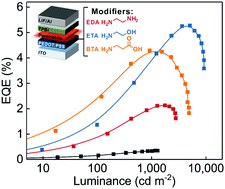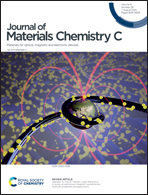Efficient pure-red perovskite light-emitting diodes using dual-Lewis-base molecules for interfacial modification†
Abstract
Perovskite light-emitting diodes (PeLEDs) are promising for full-color displays due to their high color purity, low-cost and solution processability. However, pure-red PeLEDs still lag behind their green and deep-red counterparts in efficiency and brightness. Here, we employ three structurally similar dual-Lewis-base molecules ethylenediamine, ethanolamine and beta-alanine to modify the interface between the hole transport layer (HTL) and (Cs/K/PEA)PbI3-xBrx perovskite layer for efficient pure-red PeLEDs. The functional groups in these molecules can enhance the hydrophilicity on the surface of the HTL, which improves the perovskite film quality and inhibits the formation of unfavorable low-order (n = 1 and n = 2) phases. Besides, amino groups can coordinate with interfacial defects. In particular, ethanolamine and beta-alanine enable the strong film growth modulation and passivation effect due to the presence of hydroxyl and carboxyl groups. The perovskites based on ethanolamine and beta-alanine interfacial modification give rise to enhanced photoluminescence quantum yields of up to 36.5% and 34.4%, respectively. Consequently, the optimal PeLEDs achieve a pure-red emission at 634 nm with a maximum luminance of 9218 cd m−2 and a peak external quantum efficiency of 5.27%.



 Please wait while we load your content...
Please wait while we load your content...